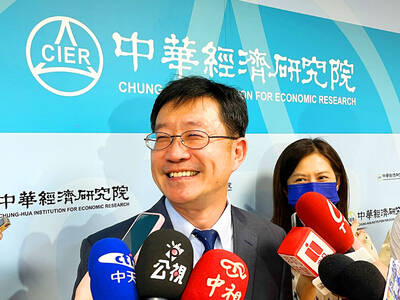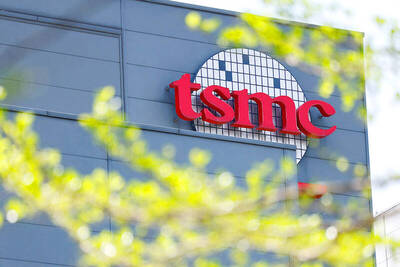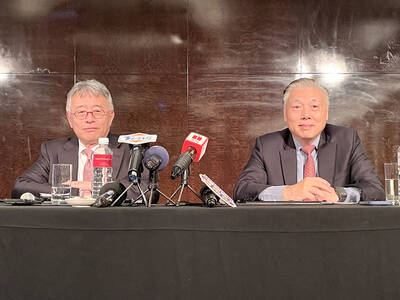Outback Australian farmers — hardened from dealing with extreme weather, fires and pests — now have to wrestle with modern trading tools and technology after a tough day tilling the land as they adapt to the rigors of a deregulated market.
For many, especially older farmers facing a bewildering host of new choices, the changes mean they may miss out on the best prices or even come under pressure to sell up to bigger farmers or foreign investors.
Farmers visited during a crop tour in eastern Australia last month had mixed feelings on the ending of the monopoly held by the Australian Wheat Board (AWB), which meant they now had to keep close tabs on day-to-day global prices.

Photo: Reuters
Wayne Dunford, 60, who grows wheat near Parkes in central--west New South Wales state, said many farmers faced an uphill task coping with the new system.
“They’re not used to things like forward selling, futures and hedging, preferring the old system where they just delivered to the wheat board under the single desk system,” Dunford said.
Some older farmers were also less technologically savvy than younger farmers or lacked the business skills required to market wheat on their own after the single desk system ended three years ago.
For nearly 60 years until 2008, AWB had sole marketing rights over the country’s wheat export sales. When restrictions were eased, commodities giants such as Cargill Inc and Glencore International swooped on the world’s fourth-largest wheat exporter, eyeing it as an opportunity to gain a new source of grain.
Canada, the world’s second largest wheat exporter, is the last major western supplier to operate a wheat marketing monopoly through the Canadian Wheat Board that has had sole marketing rights since World War II. However, the country’s conservative government plans to abolish the system in August next year.
Australia’s decision to free up the market was one many smaller farmers opposed, as they liked the system that allowed them to deliver into AWB pools while concentrating on growing grain.
“Under the old style wheat board you knew what you were going to get [in terms of price]. Our wheat board was very efficient as they knew how much wheat they had and how much they had to sell,” said Brian Johnston, 55, who farms an area 400km north of Sydney. He said farmers now had to fire up their personal computers virtually every day in an effort to get the best rates in a volatile wheat market.
“I can’t work a computer so my wife does all that — the young blokes can handle them ... they’re computer literate, but not me,” said Johnston, who has worked on his property since he was 15.
Global wheat prices have been volatile this year. The Chicago Board of Trade’s spot month contract hit a high above US$8.93 per bushel in February on concerns of dry US weather, but struck a low near US$5.65 at the start of July as Russia and Ukraine relaxed export restrictions.
Prices have climbed back to above US$7.00 since then, in line with rising corn prices.
Other farmers have got used to the new system, though they are still building up expertise.
“There’s hedging products — risk management stuff — you can sell any amount of grain forward but that’s pretty tricky at this time of the year when you don’t know how much will be produced,” said Jock Coupland, one of the largest grain growers in the Condobolin district of the New South Wales’ mid-west.
Australia starts harvesting in October. The government’s chief commodities forecaster estimated in June that the 2011-2012 harvest could be 26.2 million tonnes, near the record 26.3 million tonnes in 2010-2011, though some private estimates were lower.
“I used to deal with AWB until they abandoned the single desk but I don’t mind it — in fact I quite like the new system,” Coupland said.
However, Adam Davis, a senior commodities trader at Merricks Capital, said the new system had some deficiencies.
“There’s a plethora of so-called risk management and consultants out there to advise whether to put your grain into a pool, and which one, or sell to a trader,” Davis said. “I don’t know how a farmer can work out what he can get from a pool or whether he should wait to harvest before selling. It must be very confusing.”
Davis added that farmers had expected better prices because of competition among buyers but these gains had been whittled away by supply chain inefficiencies.
Lack of capacity at country silos has forced farmers to store more grain on farms, adding to costs, while insufficient rail capacity means using more expensive road transport.
Davis said farmers were being forced to rethink how they did business.
“We’re going through that generation change where you are just going to see the big guys get bigger and obviously the number of farms is going to shrink,” he said.
Foreign interest in Australian farmland is on the rise as countries such as Qatar seek to secure food supplies, while existing farmers are buying more land to achieve economies of scale, allowing them to use more machinery and less labor.
Some farmers, struggling to make a return because of prices, new marketing options and adverse weather, have been tempted to sell, realizing they either have to get bigger or leave their land.
“There’s a lot of land up for sale because the older guys are selling up and there’s not a lot of us younger farmers,” said Grant Orr, 26, a grain farmer near Parkes, which is about 480km west of Sydney.
“There’s no neighbors around anymore. There’s an -Englishman who has bought up a lot of land around here, as an investment I suppose, but he only comes once or twice a year,” Orr said.
“There’s blocks everywhere that are coming up for sale so it is likely they will end up in foreign hands like the Chinese and Middle East buyers,” he said.
Orr said he was not against foreign investment but he was worried that state-backed companies were buying land to secure their own food supplies.
“I feel that Australian farmers should be growing food and supplying it to countries that need it,” Orr said.
Orr and his brother Tim, 34, do not oppose the new system, but they consider it an extra chore.
“Last season we sold a lot of grain at harvest time as we were happy with prices and the fact that we got cash in the hand then but I still spent about a quarter of my time dealing with marketing,” he said.
Pools offer up-front partial payments that help cover costs, but the option of selling for cash at harvest time is attractive if prices are good enough to deliver a profit.
GrainCorp Ltd, the largest grain handler in eastern Australia, defended the new system and said some myths existed around marketing strategies.
“Under the new system they also have more control over prices as they can warehouse grain or store it on farm ... so traders have to be more competitive to secure supplies,” GrainCorp spokesman David Ginns said.

WEAKER ACTIVITY: The sharpest deterioration was seen in the electronics and optical components sector, with the production index falling 13.2 points to 44.5 Taiwan’s manufacturing sector last month contracted for a second consecutive month, with the purchasing managers’ index (PMI) slipping to 48, reflecting ongoing caution over trade uncertainties, the Chung-Hua Institution for Economic Research (CIER, 中華經濟研究院) said yesterday. The decline reflects growing caution among companies amid uncertainty surrounding US tariffs, semiconductor duties and automotive import levies, and it is also likely linked to fading front-loading activity, CIER president Lien Hsien-ming (連賢明) said. “Some clients have started shifting orders to Southeast Asian countries where tariff regimes are already clear,” Lien told a news conference. Firms across the supply chain are also lowering stock levels to mitigate

Six Taiwanese companies, including contract chipmaker Taiwan Semiconductor Manufacturing Co (TSMC, 台積電), made the 2025 Fortune Global 500 list of the world’s largest firms by revenue. In a report published by New York-based Fortune magazine on Tuesday, Hon Hai Precision Industry Co (鴻海精密), also known as Foxconn Technology Group (富士康科技集團), ranked highest among Taiwanese firms, placing 28th with revenue of US$213.69 billion. Up 60 spots from last year, TSMC rose to No. 126 with US$90.16 billion in revenue, followed by Quanta Computer Inc (廣達) at 348th, Pegatron Corp (和碩) at 461st, CPC Corp, Taiwan (台灣中油) at 494th and Wistron Corp (緯創) at

NEGOTIATIONS: Semiconductors play an outsized role in Taiwan’s industrial and economic development and are a major driver of the Taiwan-US trade imbalance With US President Donald Trump threatening to impose tariffs on semiconductors, Taiwan is expected to face a significant challenge, as information and communications technology (ICT) products account for more than 70 percent of its exports to the US, Chung-Hua Institution for Economic Research (CIER, 中華經濟研究院) president Lien Hsien-ming (連賢明) said on Friday. Compared with other countries, semiconductors play a disproportionately large role in Taiwan’s industrial and economic development, Lien said. As the sixth-largest contributor to the US trade deficit, Taiwan recorded a US$73.9 billion trade surplus with the US last year — up from US$47.8 billion in 2023 — driven by strong

ASE Technology Holding Co (ASE, 日月光投控), the world’s biggest chip assembly and testing service provider, yesterday said it would boost equipment capital expenditure by up to 16 percent for this year to cope with strong customer demand for artificial intelligence (AI) applications. Aside from AI, a growing demand for semiconductors used in the automotive and industrial sectors is to drive ASE’s capacity next year, the Kaohsiung-based company said. “We do see the disparity between AI and other general sectors, and that pretty much aligns the scenario in the first half of this year,” ASE chief operating officer Tien Wu (吳田玉) told an